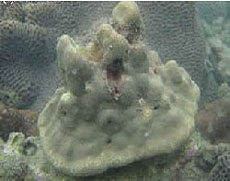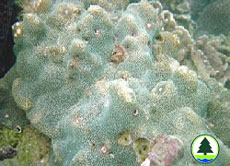|
What are the twenty coral species commonly found in Hong Kong Marine Parks?
Classification of corals?
Description of twenty selected coral species commonly found within Hong Kong Marine Park Areas
Porites lutea (Milne Edwards and Haime, 1851)
| Family: |
Poritidae |
| Genera: |
Porites |
| Species: |
lutea |
| Common name: |
Pore or boulder coral |
| Field characteristics: |
They have massive growth form and can reach large sizes (> 0.5 m in height). This form is typical of the shallow, sheltered coral habitat of the marine parks. However, P. lutea does exist in more exposed and turbid environments.In these types of physical environments colonies will adapt a submassive or encrusting growth form. The corallites of all Porites species are small. The corallite structure is the key to identifying different species of Porites and so identification underwater is difficult when species have similar growth forms, e.g., P. lutea and P. lobata, both recorded from Hong Kong. P. lutea colonies, as with other Porites species, appear smooth due to the small size of the corallites. Massive colonies typically have lobed or undulating surfaces in the shallows and form helmet-shaped colonies with ledge-like growing margins in the deeper coral habitats. Although known as night time feeders the polyps are often observed to be expanded during the day. Colour is generally uniform throughout the colony and ranges from dark to light brown and various shades of grey or green. This species is the most common Porites recorded fromHong Kong. It will not be easy to differentiate P. lutea from P. lobata in the field. |
| Abundance: |
Dominant |
| Distribution : |
Extensive local geographical distribution range recorded from western through to northeastern waters of Hong Kong. Well-represented in Hoi Ha Wan, Yan Chau Tong and Tung Ping Chau Marine Parks. Colonies of considerable size are noted from Hoi Ha Wan Marine Park and fringing communities. This species is also a dominant component in Tung Ping Chau Marine Park. |
 |
 |
| Porites lutea with the typical form of helmet shape and undulating surfaces. |
| 
